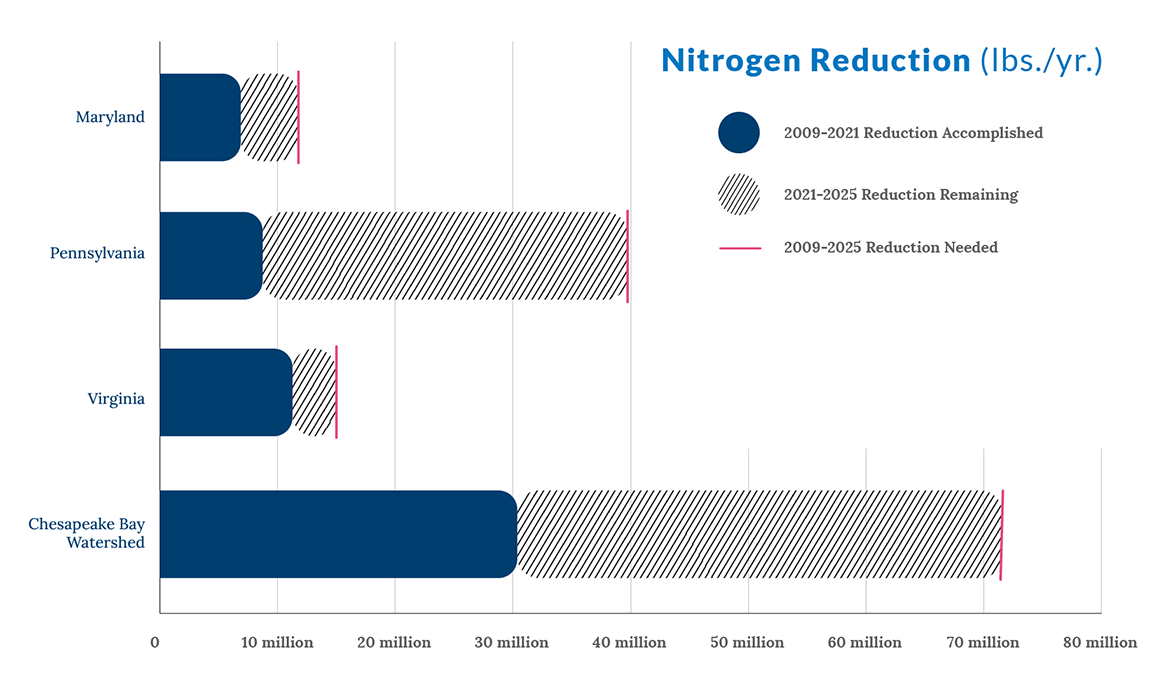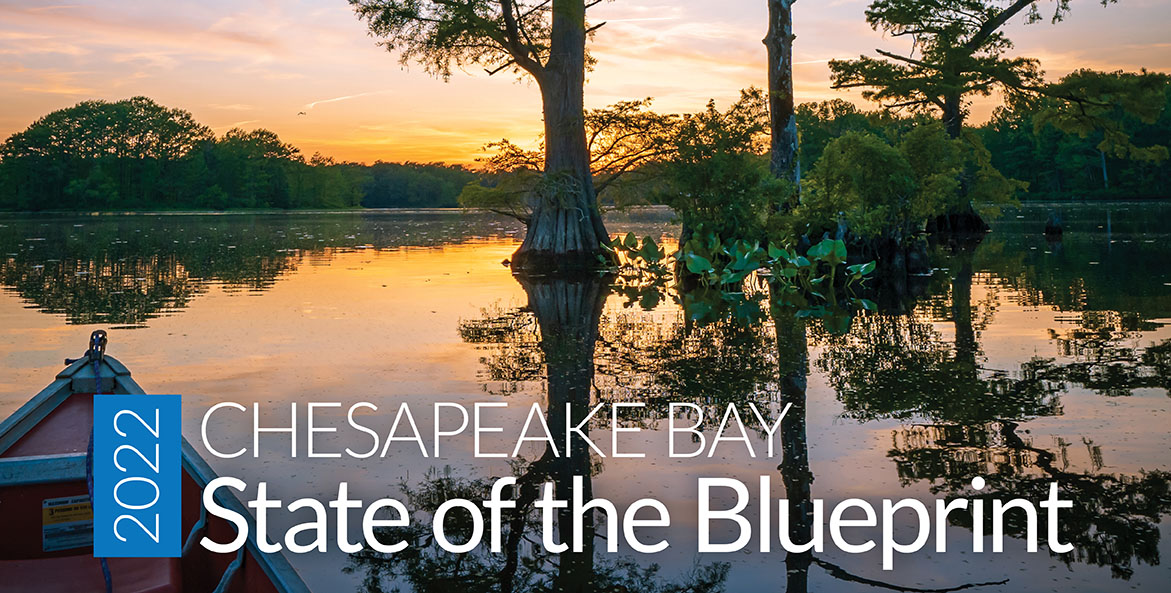Our State of the Blueprint report asks one question: Are the Bay states on track to reduce pollution by the Blueprint’s 2025 deadline?
Based on our assessment of progress in Maryland, Pennsylvania, and Virginia, which together account for roughly 90 percent of the Bay's pollution, the answer collectively is ‘no.’ States are not on track to reduce pollution to the levels needed for a healthy Bay, or implement the practices necessary to achieve them by the 2025 deadline.
Since the Blueprint was established in 2010, states have put in place practices to achieve an estimated 42 percent of the nitrogen-pollution reductions and 64 percent of the phosphorus reductions that the Blueprint requires. Much of this progress is due to reducing pollution from wastewater treatment plants. In fact, wastewater treatment upgrades are the key reason Maryland and Virginia, individually, may still meet their 2025 pollution-reduction commitments.

The above chart shows the nitrogen-pollution reductions needed under the Chesapeake Clean Water Blueprint; the reductions achieved between 2009 and 2021; and the reductions that remain to be completed in Maryland, Pennsylvania, Virginia, and the Chesapeake Bay Watershed as a whole.
Chesapeake Bay Foundation
This progress, however, is nowhere near enough to make up for pollution from agriculture and growing urban and suburban areas. Agriculture accounts for the bulk of the remaining pollution watershed-wide, and no state is on track to reduce it enough. Pennsylvania—given its significantly larger agricultural footprint in the watershed and past under investment in conservation programs—is especially far off track. These issues raise serious concerns about the ability to improve and sustain water quality over the long term.
The Blueprint has proven to be the best way yet to restore clean water to the Chesapeake Bay region. Still, getting restoration back on track requires an urgent recommitment to the Bay restoration partnership, including a plan with clear timelines to achieve the remaining Blueprint commitments and address serious new challenges like climate change. Accountability is essential at all levels, with the U.S. Environmental Protection Agency as the final backstop.
2025 is a deadline, not a finish line. The pollution reductions required by the Blueprint to achieve clean water must not only be met, but also sustained over the long term. Climate change and continued population growth in the watershed will only make the job harder the longer we wait. We can still leave a healthy, resilient watershed for the next generation, but we must act now.
About the Blueprint
The Chesapeake Clean Water Blueprint is the historic federal-state plan established in 2010 to restore the Bay’s water quality and, in doing so, also improve the many streams and rivers that feed it. It outlines four very important requirements:
- Pollution limits for nitrogen, phosphorus, and sediment set by the U.S. Environmental Protection Agency (EPA), known as a Total Maximum Daily Load (TMDL).
- Plans to meet those limits developed by each of the six Bay states and the District of Columbia, known as Watershed Implementation Plans (WIPs, referred to here as state Clean Water Blueprints).
- Milestones—two-year, incremental goals to keep progress on track.
- Accountability measures by which EPA must hold all states accountable for developing and implementing adequate plans to meet the pollution limits.
The Blueprint calls for all Bay jurisdictions to have in place, by 2025, the practices and policies necessary to meet the Bay's pollution limits. The jurisdictions are currently implementing their final Clean Water Blueprints (Phase III WIPs) to achieve the remaining pollution reductions.
What We Found
We assessed progress in Maryland, Pennsylvania, and Virginia, the three states that account for roughly 90 percent of Bay pollution. To do so, we looked at two measures.
First, we used the Chesapeake Bay Program's scientific model to estimate pollution reductions made between 2009 and 2021. For each state, we assessed both the total pollution reductions made statewide, as well as the reductions made by each sector (i.e., agriculture, wastewater, etc.) to determine if current trends put them on track to meet the 2025 Blueprint commitments. This is an important distinction. While significant progress in one sector may put a state on track to meet its total 2025 commitments today, states risk losing ground or even reversing progress in the future without action in all sectors.
Second, we looked at how well the states are implementing practices and programs outlined in their two-year milestone commitments for 2021 and 2022—in other words, are they taking the specific actions they committed to do to achieve their pollution reductions? Plans are only good if they are implemented. By looking at whether or not the plans are being put into place, our report assesses interim progress toward achieving some of these milestone targets as well as overall progress toward meeting the 2025 implementation deadline.
By these measures, we found that no state is completely on track. Model projections indicate Maryland, Virginia, and Pennsylvania will achieve their 2025 commitments for wastewater, but not for agriculture or urban and suburban runoff. This progress in the wastewater sector may allow Maryland and Virginia to meet their commitments overall. Due to its large agricultural sector, Pennsylvania remains far off track despite its success with wastewater.
- Maryland remains on track to meet its overall 2025 pollution-reduction commitments. However, there are red flags. The state’s progress relies heavily on technology upgrades at wastewater treatment plants, but operational failures at two of the largest plants jeopardize its gains. Moreover, this one sector alone cannot sustain progress over the long term. Agricultural pollution is declining as more conservation practices are placed on farms, though not fast enough to meet the state’s commitments. And polluted runoff from urban and suburban areas is growing. Maryland must broaden its pollution-reduction strategy to manage these sources, blunt the effects of climate change, and ensure all communities benefit from investments in clean water.
SEE MARYLAND'S PROGRESS
- Despite growing efforts by farmers, municipalities, and many others working to restore clean water to the Commonwealth, Pennsylvania remains significantly off track. It will not meet its 2025 Blueprint commitments and does not yet have an EPA-approved final plan to do so. Wastewater is one area of success, but unlike in other states, it is not enough to make up for the lack of progress elsewhere. The scale of the agricultural challenge in Pennsylvania is enormous; more than 90 percent of remaining pollution reductions are expected from farms. The state’s new Agricultural Conservation Assistance Program (ACAP) and increased funding for federal conservation programs are significant, but increased and sustained funding is critical. Climate change and the loss of farms and forests to development also challenge pollution reductions.
SEE PENNSYLVANIA'S PROGRESS
- Virginia remains on track to achieve its 2025 pollution-reduction commitments, largely due to wastewater treatment plants, which account for over 90 percent of its nitrogen and phosphorus reductions since the Blueprint’s establishment. This progress currently keeps Virginia on track overall, even though the Commonwealth is not meeting commitments to reduce polluted runoff from agriculture and urban and suburban areas. Long term, this is not sustainable, especially when pollution from stormwater continues to grow. To meet its 2025 commitments, Virginia must rapidly accelerate pollution reductions from these sources. Recent increased investments are a promising step, but these funding levels must be maintained and targeted to the most beneficial pollution-reduction practices, such as planting streamside forest buffers.
SEE VIRGINIA'S PROGRESS
Progress Toward Pollution-Reduction Targets
We used the Chesapeake Bay Program’s scientific model to estimate pollution reductions made between 2009 and 2021 and if those reductions are on a trajectory to meet the 2025 targets, both statewide and for each sector. Maryland, Pennsylvania, and Virginia's pollution-reduction progress is summarized in the table below. Together, the three states account for roughly 90 percent of the Bay's pollution.
| Nitrogen | Phosphorus | |||||
|---|---|---|---|---|---|---|
| MDMaryland | ||||||
| Agriculture | In Danger | Off Track | ||||
| Urban/Suburban Polluted Runoff |
Off Track And Pollution Increasing |
Off Track | ||||
| Septic | Off Track | N/A | ||||
| Wastewater & Combined Sewer Outfall | On Track | In Danger | ||||
| Overall | On Track | On Track | ||||
| PAPennsylvania | ||||||
| Agriculture | Off Track | Off Track | ||||
| Urban/Suburban Polluted Runoff |
Off Track And Pollution Increasing |
Off Track | ||||
| Septic | Off Track | N/A | ||||
| Wastewater & Combined Sewer Outfall | On Track | On Track | ||||
| Overall | Off Track | In Danger | ||||
| VAVirginia | ||||||
| Agriculture | Off Track | Off Track | ||||
| Urban/Suburban Polluted Runoff |
Off Track And Pollution Increasing |
Off Track | ||||
| Septic | Off Track | N/A | ||||
| Wastewater & Combined Sewer Outfall | On Track | On Track | ||||
| Overall | On Track | On Track | ||||
| Off Track | Projected loads more than 25% off target or pollution is increasing |
| In Danger of Being Off Track | Projected loads within 10-25% of target |
| On Track | Projected loads less than 10% off target |
| N/A | No contribution from this source sector |
Any increasing trendline is red, regardless of percentage
Pollution-reduction progress is assessed with modeled estimates of the benefits from implemented practices such as upgrades to wastewater treatment plants, best management practices like cover crops and streamside forested buffers on agricultural lands, and stormwater practices, like rain gardens, in urban areas. The “Total” progress for each state is assessed against the overall pollution-reduction target EPA assigned each state in order to meet the Blueprint targets by 2025. Each state is responsible for dividing EPA’s total allotment among the various pollution sources (sectors) in their state Clean Water Blueprints (Watershed Implementation Plans or WIPs). The progress for each sector (i.e. agriculture) is therefore assessed against the pollution-reduction target assigned to it in the states’ most recent Phase III WIPs.
Getting Restoration Back on Track
Reducing pollution remains the single most urgent priority to restore the Chesapeake Bay, and the Blueprint has proven to be the best way yet to do so. Despite significant success reducing pollution from wastewater, programs to address pollution from agriculture and stormwater from urban and suburban areas continue to fall woefully short. Addressing these sources is the defining challenge the partnership now faces. Doing so will require targeting investments, rewarding innovation, broadening community involvement, increasing accountability measures, and accounting for the major threat posed by climate change. Learn more about current and future challenges.
What You Can Do
We can still leave a healthy, resilient watershed for the next generation, but we must act now and continue working together to save the Bay. To achieve clean water, the Bay states must not only meet their pollution-reduction commitments as quickly as possible, but also sustain the reductions over the long term. We cannot afford delay. Climate change and continued population growth in the watershed will only make the job harder the longer we wait. Join CBF's Action Network and be the first to know how you can help in the fight to save the Bay and its rivers and streams. Join us today



